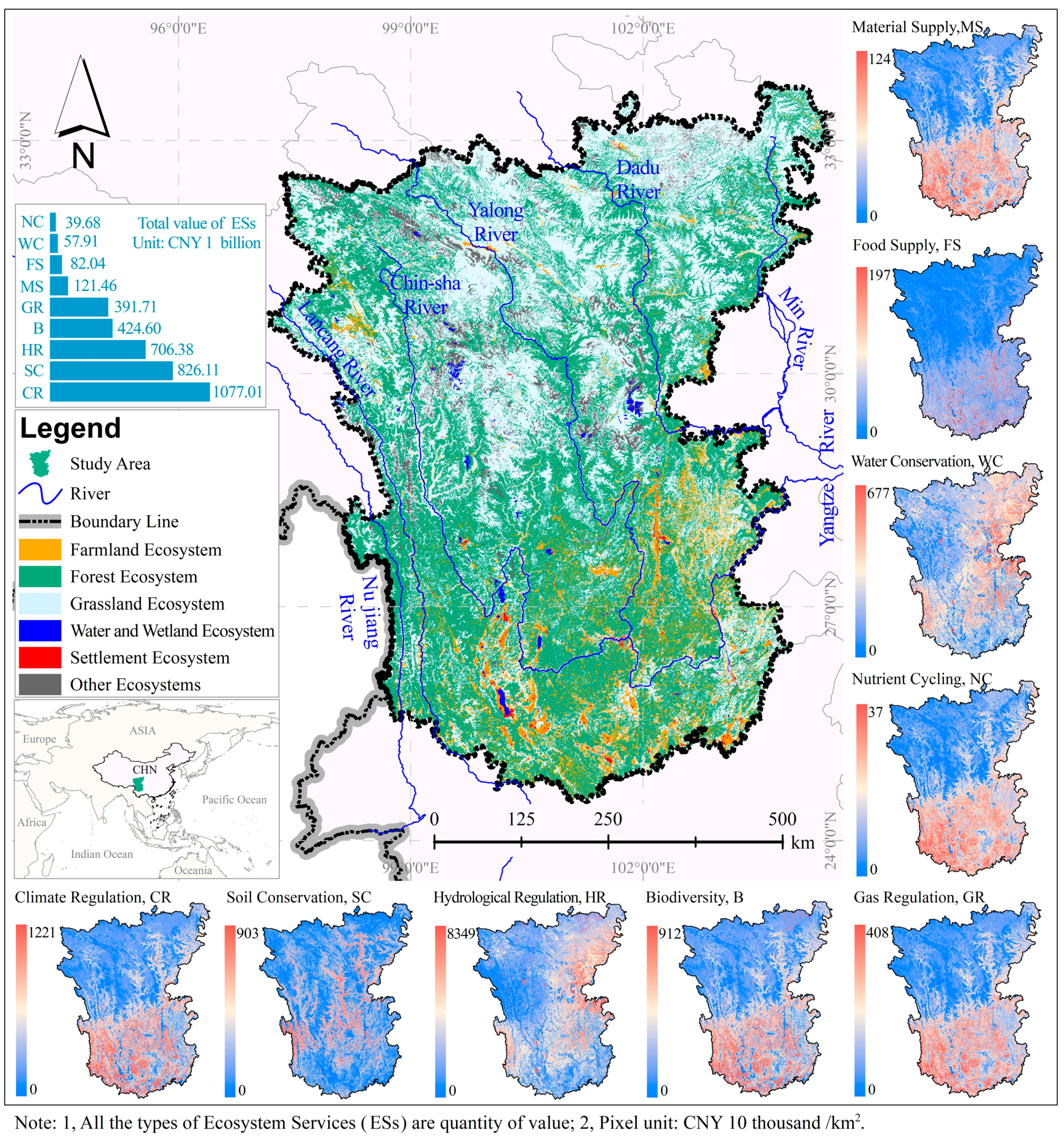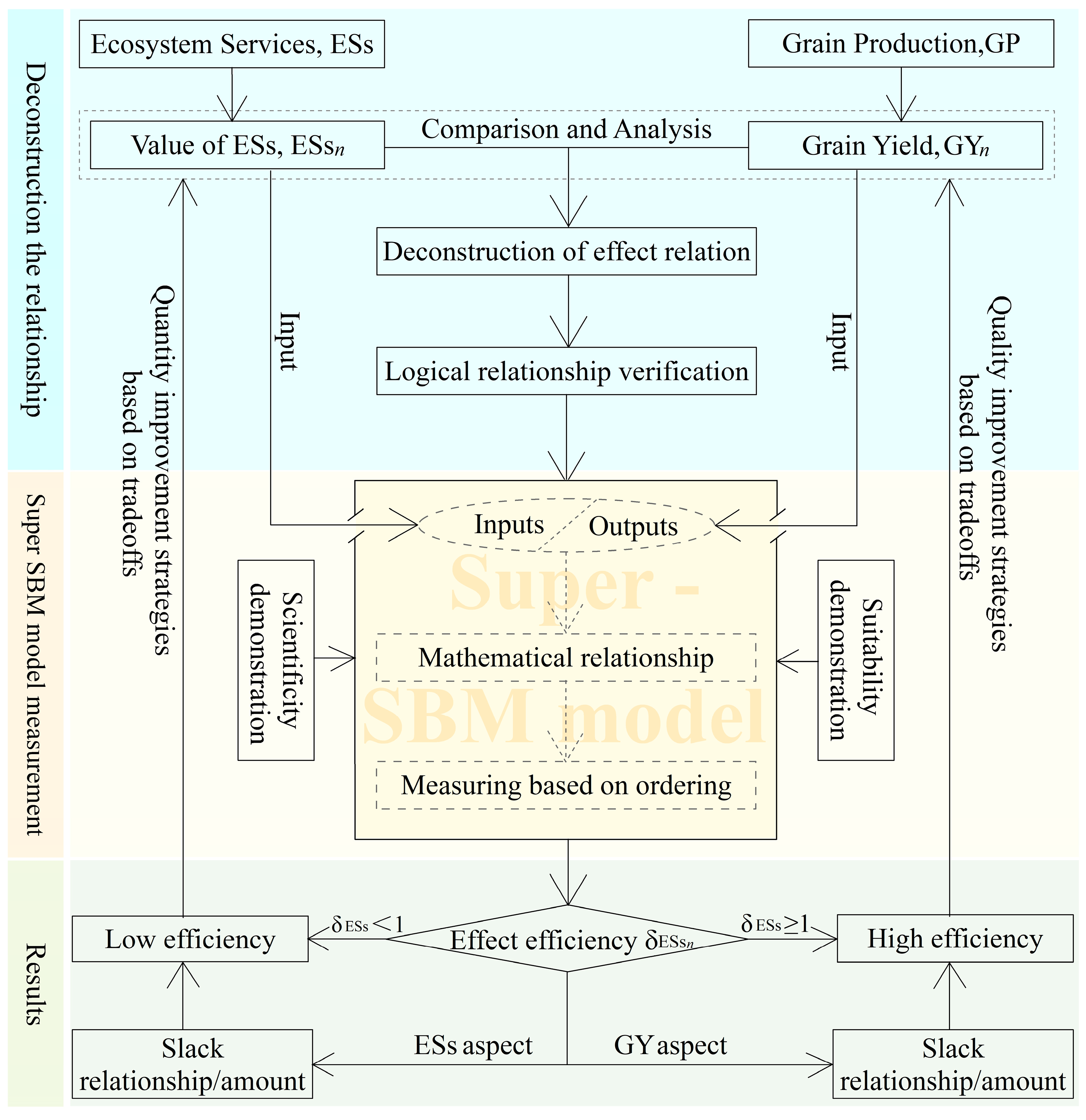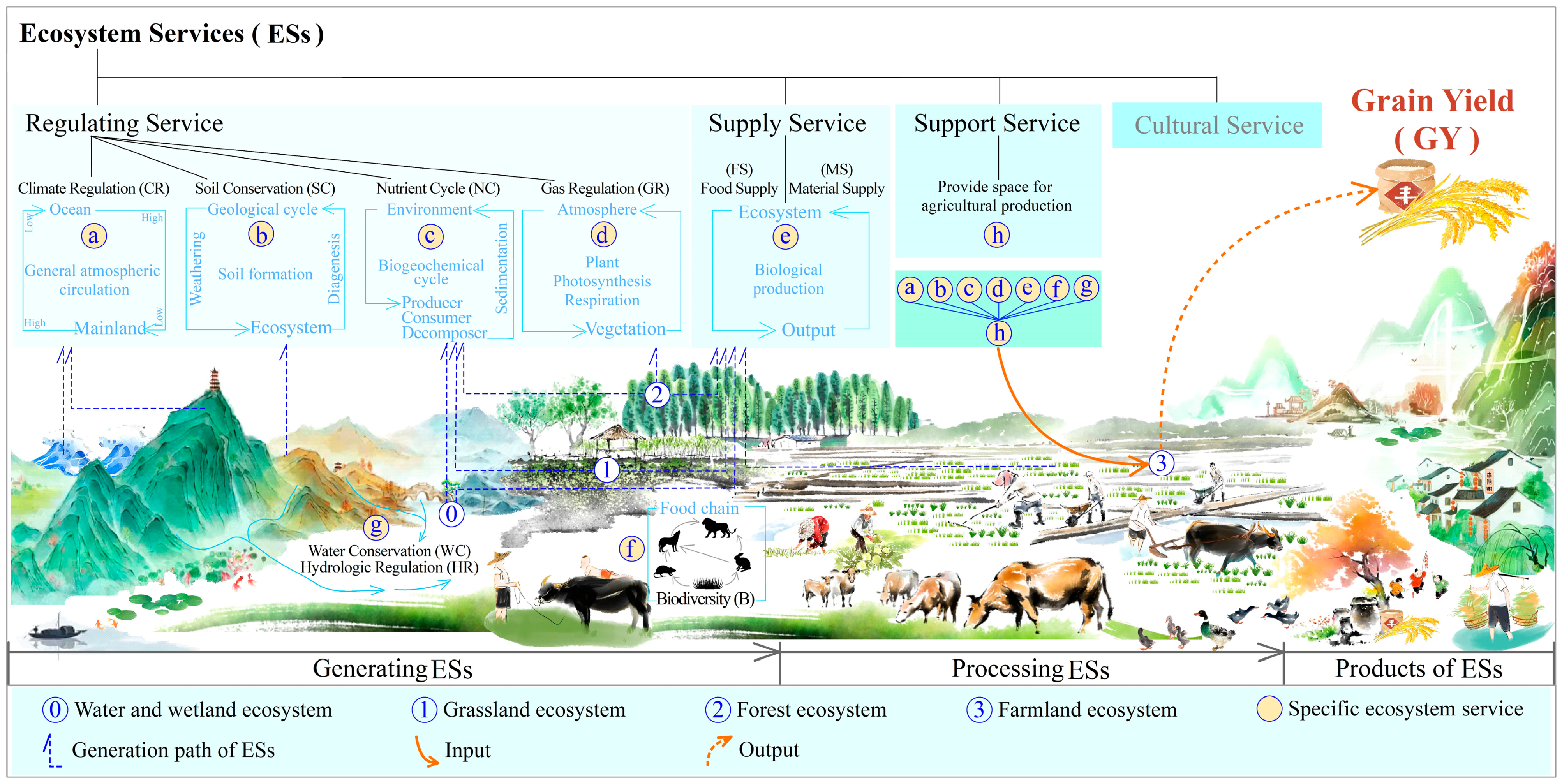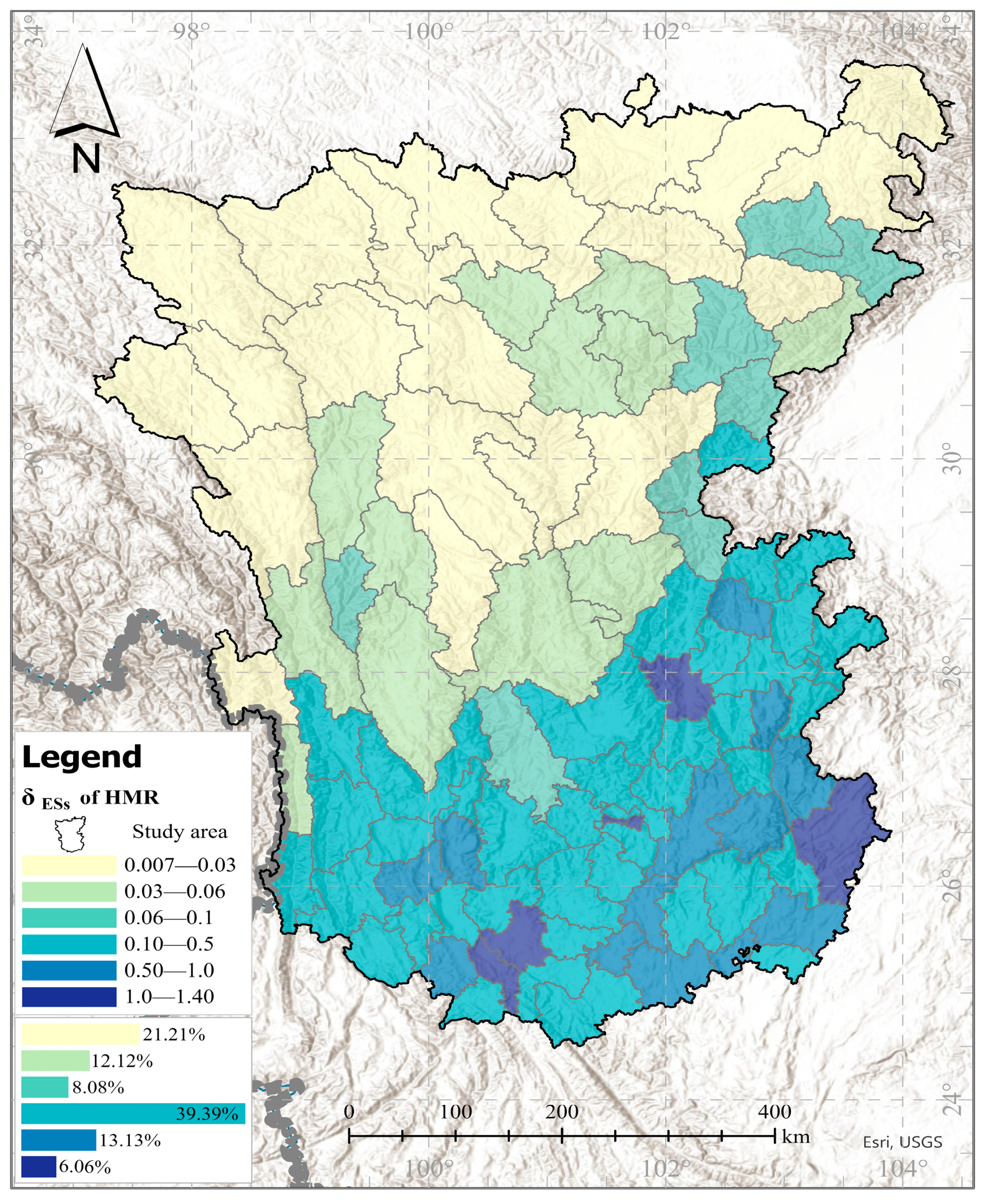Supporting Efficiency Measurement and Tradeoff Optimization Methods of Ecosystem Services on Grain Production
Abstract
:1. Introduction
2. Materials and Methods
2.1. The Study Area Overview
2.2. Data Sources
2.3. Methodology
2.3.1. Logical Framework and Technical Approach
2.3.2. Deconstruction of the Role Mechanism of ESs in GP
2.3.3. Basic Simulation Logic of the Super-SBM Model
2.3.4. Simulation Method of the Super-SBM Model
2.3.5. Justification for the Suitability of the Modeling Approach
3. Results
3.1. The Efficient Frontier of ESs to GP
3.2. Supporting Efficiency of ESs to GP
3.3. Slacks in ESs and GP
3.4. Classification of Tradeoffs Based on Slack Relationships
3.5. Optimized Strategies Based on Tradeoff Relationships
4. Discussion
4.1. Links and Differences with Related Studies
4.2. Consistency of the Results with General Rules
4.3. Limited Assistance to the Optimization Strategy
4.4. Objective Cognitive Model Measurement Results
4.5. Problems and Shortcomings
5. Conclusions
Author Contributions
Funding
Data Availability Statement
Acknowledgments
Conflicts of Interest
References
- Millennium Ecosystem Assessment. Ecosystems and Human Well-Being: Synthesis; Island Press: Washington, DC, USA, 2005; Available online: https://millenniumassessment.org/zh/index.html (accessed on 16 September 2023).
- Poppy, G.M.; Jepson, P.C.; Pickett, J.A.; Birkett, M.A. Achieving food and environmental security: New approaches to close the gap. Philos. Trans. R. Soc. B-Biol. Sci. 2014, 369, 20120272. [Google Scholar] [CrossRef] [PubMed]
- Smith, E.N.; van Aalst, M.; Tosens, T.; Niinemets, U.; Stich, B.; Morosinotto, T.; Alboresi, A.; Erb, T.J.; Gomez-Coronado, P.A.; Tolleter, D.; et al. Improving photosynthetic efficiency toward food security: Strategies, advances, and perspectives. Mol. Plant 2023, 16, 1547–1563. [Google Scholar] [CrossRef] [PubMed]
- Olesen, R.S.; Hall, C.M.; Rasmussen, L.V. Forests support people’s food and nutrition security through multiple pathways in low- and middle-income countries. One Earth 2022, 5, 1342–1353. [Google Scholar] [CrossRef]
- Tilman, D.; Fargione, J.; Wolff, B.; D’Antonio, C.; Dobson, A.; Howarth, R.; Schindler, D.; Schlesinger, W.H.; Simberloff, D.; Swackhamer, D. Forecasting agriculturally driven global environmental change. Science 2001, 292, 281–284. [Google Scholar] [CrossRef] [PubMed]
- Bommarco, R.; Kleijn, D.; Potts, S.G. Ecological intensification: Harnessing ecosystem services for food security. Trends Ecol. Evol. 2013, 28, 230–238. [Google Scholar] [CrossRef] [PubMed]
- Letourneau, D.K.; Armbrecht, I.; Salguero Rivera, B.; Montoya Lerma, J.; Jimenez Carmona, E.; Constanza Daza, M.; Escobar, S.; Galindo, V.; Gutierrez, C.; Duque Lopez, S.; et al. Does plant diversity benefit agroecosystems? A synthetic review. Ecol. Appl. 2011, 21, 9–21. [Google Scholar] [CrossRef] [PubMed]
- Tamm, L.; Thürig, B.; Fliessbach, A.; Gottlieb, A.E.; Karavani, S.; Cohen, Y. Elicitors and soil management to induce resistance against fungal plant diseases. Njas-Wagening. J. Life Sci. 2011, 58, 131–137. [Google Scholar] [CrossRef]
- Foley, J.A.; DeFries, R.; Asner, G.P.; Barford, C.; Bonan, G.; Carpenter, S.R.; Chapin, F.S.; Coe, M.T.; Daily, G.C.; Gibbs, H.K.; et al. Global consequences of land use. Science 2005, 309, 570–574. [Google Scholar] [CrossRef] [PubMed]
- Dungan, R.S.; Leytem, A.B.; Moore, A.D.; Bjorneberg, D.L.; Grace, P.R.; Brunk, C.; Rowlings, D.W. Growing and non-growing season nitrous oxide emissions from a manured semiarid cropland soil under irrigation. Agric. Ecosyst. Environ. 2023, 348, 108413. [Google Scholar] [CrossRef]
- Gardner, J.B.; Drinkwater, L.E. The fate of nitrogen in grain cropping systems: A meta-analysis of 15 N field experiments. Ecol. Appl. 2009, 19, 2167–2184. [Google Scholar] [CrossRef]
- Kravchenko, A.N.; Robertson, G.P. Whole-Profile Soil Carbon Stocks: The Danger of Assuming Too Much from Analyses of Too Little. Soil Sci. Soc. Am. J. 2011, 75, 235–240. [Google Scholar] [CrossRef]
- Sukhoveeva, O.; Karelin, D.; Lebedeva, T.; Pochikalov, A.; Ryzhkov, O.; Suvorov, G.; Zolotukhin, A. Greenhouse gases fluxes and carbon cycle in agroecosystems under humid continental climate conditions. Agric. Ecosyst. Environ. 2023, 352, 108502. [Google Scholar] [CrossRef]
- Pretty, J.; Bharucha, Z.P. Sustainable intensification in agricultural systems. Ann. Bot. 2014, 114, 1571–1596. [Google Scholar] [CrossRef] [PubMed]
- Matson, P.A.; Parton, W.J.; Power, A.G.; Swift, M.J. Agricultural intensification and ecosystem properties. Science 1997, 277, 504–509. [Google Scholar] [CrossRef] [PubMed]
- Moss, B. Water pollution by agriculture. Philos. Trans. R. Soc. B-Biol. Sci. 2008, 363, 659–666. [Google Scholar] [CrossRef] [PubMed]
- Cassman, K.G.; Dobermann, A.; Walters, D.T.; Yang, H. Meeting cereal demand while protecting natural resources and improving environmental quality. Annu. Rev. Environ. Resour. 2003, 28, 315–358. [Google Scholar] [CrossRef]
- Chen, B.M.; Feng, W.T.; Jing, X.; Wang, Y.G. Dryland agricultural expansion leads to lower content and higher variability of soil inorganic carbon in topsoil. Agric. Ecosyst. Environ. 2023, 356, 108620. [Google Scholar] [CrossRef]
- Adams, W.M.; Aveling, R.; Brockington, D.; Dickson, B.; Elliott, J.; Hutton, J.; Roe, D.; Vira, B.; Wolmer, W. Biodiversity conservation and the eradication of poverty. Science 2004, 306, 1146–1149. [Google Scholar] [CrossRef] [PubMed]
- Gaba, S.; Lescourret, F.; Boudsocq, S.; Enjalbert, J.; Hinsinger, P.; Journet, E.P.; Navas, M.L.; Wery, J.; Louarn, G.; Malézieux, E.; et al. Multiple cropping systems as drivers for providing multiple ecosystem services: From concepts to design. Agron. Sustain. Dev. 2015, 35, 607–623. [Google Scholar] [CrossRef]
- Lal, R. Soil carbon sequestration impacts on global climate change and food security. Science 2004, 304, 1623–1627. [Google Scholar] [CrossRef]
- Lobell, D.B.; Burke, M.B.; Tebaldi, C.; Mastrandrea, M.D.; Falcon, W.P.; Naylor, R.L. Prioritizing climate change adaptation needs for food security in 2030. Science 2008, 319, 607–610. [Google Scholar] [CrossRef] [PubMed]
- Gaupp, F. Extreme Events in a Globalized Food System. One Earth 2020, 2, 518–521. [Google Scholar] [CrossRef] [PubMed]
- Wheeler, T.; von Braun, J. Climate Change Impacts on Global Food Security. Science 2013, 341, 508–513. [Google Scholar] [CrossRef] [PubMed]
- Cordell, D.; Drangert, J.O.; White, S. The story of phosphorus: Global food security and food for thought. Glob. Environ. Chang.-Hum. Policy Dimens. 2009, 19, 292–305. [Google Scholar] [CrossRef]
- Sundram, P. Food security in ASEAN: Progress, challenges and future. Front. Sustain. Food Syst. 2023, 7, 1260619. [Google Scholar] [CrossRef]
- Aragie, E.; Balie, J.; Morales, C.; Pauw, K. Synergies and trade-offs between agricultural export promotion and food security: Evidence from African economies. World Dev. 2023, 172, 106368. [Google Scholar] [CrossRef]
- Neumann, K.; Verburg, P.H.; Stehfest, E.; Müller, C. The yield gap of global grain production: A spatial analysis. Agric. Syst. 2010, 103, 316–326. [Google Scholar] [CrossRef]
- Calvin, K.; Cowie, A.; Berndes, G.; Arneth, A.; Cherubini, F.; Portugal-Pereira, J.; Grassi, G.; House, J.; Johnson, F.X.; Popp, A.; et al. Bioenergy for climate change mitigation: Scale and sustainability. Glob. Chang. Biol. Bioenergy 2021, 13, 1346–1371. [Google Scholar] [CrossRef]
- Liu, L.Q.; Wang, X.Y.; Meng, X.Z.; Cai, Y.Y. The coupling and coordination between food production security and agricultural ecological protection in main food-producing areas of China. Ecol. Indic. 2023, 154, 110785. [Google Scholar] [CrossRef]
- Tylianakis, J.M.; Didham, R.K.; Bascompte, J.; Wardle, D.A. Global change and species interactions in terrestrial ecosystems. Ecol. Lett. 2008, 11, 1351–1363. [Google Scholar] [CrossRef]
- Xu, X.L.; Liu, J.Y.; Zhang, S.W.; Li, R.D.; Yan, C.Z.; Wu, S.X. China Multi-Period Land Use Remote Sensing Monitoring Dataset (CNLUCC); Institute of Geographic Sciences and Natural Resources Research, Chinese Academy of Sciences (CAS): Beijing, China, 2018. [Google Scholar] [CrossRef]
- Xu, X.L. Spatial Distribution Data of Ecosystem Types in China across Multiple Periods; Institute of Geographic Sciences and Natural Resources Research, Chinese Academy of Sciences (CAS): Beijing, China, 2023. [Google Scholar] [CrossRef]
- Costanza, R.; dArge, R.; deGroot, R.; Farber, S.; Grasso, M.; Hannon, B.; Limburg, K.; Naeem, S.; Oneill, R.V.; Paruelo, J.; et al. The value of the world’s ecosystem services and natural capital. Nature 1997, 387, 253–260. [Google Scholar] [CrossRef]
- El Mujtar, V.; Muñoz, N.; Mc Cormick, B.P.; Pulleman, M.; Tittonell, P. Role and management of soil biodiversity for food security and nutrition; where do we stand? Glob. Food Secur.-Agric. Policy Econ. Environ. 2019, 20, 132–144. [Google Scholar] [CrossRef]
- Yuan, M.H.; Lo, S.L. Ecosystem services and sustainable development: Perspectives f1 rom the food-energy-water Nexus. Ecosyst. Serv. 2020, 46, 101217. [Google Scholar] [CrossRef]
- Rehman, A.; Farooq, M.; Lee, D.J.; Siddique, K.H.M. Sustainable agricultural practices for food security and ecosystem services. Environ. Sci. Pollut. Res. 2022, 29, 84076–84095. [Google Scholar] [CrossRef] [PubMed]
- Tone, K. A slacks-based measure of efficiency in data envelopment analysis. Eur. J. Oper. Res. 2001, 130, 498–509. [Google Scholar] [CrossRef]
- Li, Y.; Chen, Y.Y. Development of an SBM-ML model for the measurement of green total factor productivity: The case of pearl river delta urban agglomeration. Renew. Sustain. Energy Rev. 2021, 145, 111131. [Google Scholar] [CrossRef]
- Lotfi, F.H.; Saen, R.F.; Moghaddas, Z.; Vaez-Ghasemi, M. Using an SBM-NDEA model to assess the desirable and undesirable outputs of sustainable supply chain: A case study in wheat industry. Socio-Econ. Plan. Sci. 2023, 89, 101699. [Google Scholar] [CrossRef]
- Zhang, J.R.; Zeng, W.H.; Wang, J.N.; Yang, F.L.; Jiang, H.Q. Regional low-carbon economy efficiency in China: Analysis based on the Super-SBM model with CO2 emissions. J. Clean. Prod. 2017, 163, 202–211. [Google Scholar] [CrossRef]
- Shah, W.U.H.; Hao, G.; Yasmeen, R.; Kamal, M.A.; Khan, A.; Padda, I.U.H. Unraveling the role of China’s OFDI, institutional difference and B&R policy on energy efficiency: A meta-frontier super-SBM approach. Environ. Sci. Pollut. Res. 2022, 29, 56454–56472. [Google Scholar] [CrossRef]
- Huang, L.; Zhang, Y.; Xu, X. Spatial-Temporal Pattern and Influencing Factors of Ecological Efficiency in Zhejiang-Based on Super-SBM Method. Environ. Model. Assess. 2023, 28, 227–243. [Google Scholar] [CrossRef]
- Chen, F.; Zhao, T.; Xia, H.; Cui, X.; Li, Z. Allocation of carbon emission quotas in Chinese provinces based on Super-SBM model and ZSG-DEA model. Clean Technol. Environ. Policy 2021, 23, 2285–2301. [Google Scholar] [CrossRef]
- Zhang, R.L.; Liu, X.H. Evaluating ecological efficiency of Chinese industrial enterprise. Renew. Energy 2021, 178, 679–691. [Google Scholar] [CrossRef]
- Lu, X.H.; Chen, D.L.; Kuang, B.; Zhang, C.Z.; Cheng, C. Is high-tech zone a policy trap or a growth drive? Insights from the perspective of urban land use efficiency. Land Use Policy 2020, 95, 104583. [Google Scholar] [CrossRef]
- Liu, G.W.; Fu, X.Y.; Zhuang, T.Z.; Huang, R.P.; Wu, H.J. Provincial performance assessment of neighborhood regeneration based on a super-SBM model and the Malmquist indices: A China study. Sustain. Prod. Consum. 2022, 32, 593–606. [Google Scholar] [CrossRef]
- Tone, K.; Toloo, M.; Izadikhah, M. A modified slacks-based measure of efficiency in data envelopment analysis. Eur. J. Oper. Res. 2020, 287, 560–571. [Google Scholar] [CrossRef]
- Lee, H.S. Integrating SBM model and Super-SBM model: A one-model approach. Omega-Int. J. Manag. Sci. 2022, 113, 102693. [Google Scholar] [CrossRef]
- Lin, R.Y.; Yang, W.; Huang, H.L. A modified slacks-based super-efficiency measure in the presence of negative data. Comput. Ind. Eng. 2019, 135, 39–52. [Google Scholar] [CrossRef]
- Lin, S.G.; Shi, H.L.; Wang, Y.M. An integrated slacks-based super-efficiency measure in the presence of nonpositive data. Omega-Int. J. Manag. Sci. 2022, 111, 102669. [Google Scholar] [CrossRef]
- Rasul, G.; Hussain, A.; Adhikari, L.; Molden, D.J. Conserving agrobiodiversity for sustainable food systems in the Hindu Kush Himalaya. Int. J. Agric. Sustain. 2022, 20, 1117–1135. [Google Scholar] [CrossRef]
- Delzeit, R.; Zabel, F.; Meyer, C.; Václavík, T. Addressing future trade-offs between biodiversity and cropland expansion to improve food security. Reg. Environ. Chang. 2017, 17, 1429–1441. [Google Scholar] [CrossRef]







| Province | City | County | Quantity |
|---|---|---|---|
| Xizang | Qamdo | Chagyab, Gonjo, Gyamda, Markham | 4 |
| Yunnan | Dali | Binchuan, Dali, Eryuan, Heqing, Jianchuan, Midu, Nanjian, Weishan, Xiangyun, Yangbi, Yongping, Yunlong | 12 |
| Chuxiong | Chuxiong, Dayao, Lufeng, Mouding, Nanhua, Wuding, Yao’an, Yongren, Yuanmou | 9 | |
| Diqing | Deqin, Weixi, Shangri-la | 3 | |
| Kunming | Dongchuan, Fumin, Luquan, Xundian, Songming | 5 | |
| Lijiang | The Old Town, Huaping, Ninglang, Yongsheng, Yulong | 5 | |
| Nujiang | Fugong, Gongshan, Lanping, Lushui | 4 | |
| Qujing | Huize | 1 | |
| Zhaotong | Qiaojia | 1 | |
| Sichuan | Aba | Ngapa, Heishui, Hongyuan, Jinchuan, Jiuzhaigou, Li, Barkam, Mao, Rangtang, Songpan, Xiaojin, Wenchuan | 12 |
| Ganzi | Batang, Baiyu, Danba, Daocheng, Daofu, Dege, Derong, Ganzi, Jiulong, Kangding, Litang, Luhuo, Seda, Xiangcheng, Xinlong, Yajiang, Luding | 17 | |
| Leshan | Ebian | 1 | |
| Liangshan | Butuo, Dechang, Ganluo, Huidong, Jinyang, Leibo, Meigu, Mianning, Muli, Ningnan, Puge, Xichang, Xide, Yanyuan, Yuexi, Zhaojue, Huili | 17 | |
| Panzhihua | Dongqu, Xiqu, Renhe, Miyi, Yanbian | 5 | |
| Ya’an | Baoxing, Shimian, Tianquan | 3 | |
| total | 99 | ||
| Number | Data Type | Data Publishing Authority | Data Source | Time |
|---|---|---|---|---|
| 1 | Ecosystem Services (ESs). | Chinese Academy of Sciences | the Center for Resource and Environmental Science and Data (http://www.resdc.cn/DOI) (accessed on 18 October 2023) | 2020 |
| 2 | Land use | Chinese Academy of Sciences | the Center for Resource and Environmental Science and Data (http://www.resdc.cn/DOI) (accessed on 18 October 2023) | 2020 |
| 3 | Grain Yield (GY) | National Bureau of Statistics of China | China County Statistical Yearbook (County and City Volume) (https://www.stats.gov.cn/) (accessed on 18 October 2023) | 2020 |
| Types | ESs of MA | Selected | The ESs as x in Super-SBM Model | Reason |
|---|---|---|---|---|
| Supporting Services | Soil formation | √ | Soil conservation | Directly support GP |
| Nutrient cycling | √ | Nutrient cycling | Direct supply of nutrients needed for GP | |
| Primary production | × | — | Emphasis on process, including GP itself | |
| Provisioning Services | Food | √ | Food supply | Directly Affecting GP |
| Fuelwood | √ | Material supply | Acting as an auxiliary, indirectly affecting GP | |
| Fiber | √ | Material supply | Acting as an auxiliary, indirectly affecting GP | |
| Fresh water | √ | Water conservation | Provide water resources quantity needed for GP | |
| Biodiversity | √ | Biodiversity | Control of pests and diseases in the process of GP | |
| Genetic resources | × | — | Determines the sustainability of GP, has no impact on the process of GP | |
| Regulating Services | Water regulation | √ | Water conservation | Provide sustainable water resources for GP |
| Climate regulation | √ | Climate regulation | Provide suitable climatic conditions for GP | |
| Hydrologic regulation | √ | Hydrologic regulation | Regulate water resources of GP in terms of time and space | |
| Gas regulation | √ | Gas regulation | Supply and regulate the gases needed for GP | |
| Water purification | × | — | Not serving the process of GP | |
| Cultural Services | Spiritual | × | — | Not serving the process of GP |
| Religious | × | — | Not serving the process of GP | |
| Recreation | × | — | Not serving the process of GP | |
| Ecotourism | × | — | Not serving the process of GP | |
| Aesthetic | × | — | Not serving the process of GP | |
| Inspirational | × | — | Not serving the process of GP | |
| Educational | × | — | Not serving the process of GP | |
| Sense of place | × | — | Not serving the process of GP | |
| Cultural heritage | × | — | Not serving the process of GP |
| Efficiency | The Slack Relationships | Meaning | Number of Counties | Slack Types | Tradeoff Types |
|---|---|---|---|---|---|
| < 1 Low efficiency | Slack of GY > 0 and Slack of ESs > 0 | High increasing potential of GY and low supply pressure of ESs | 83 | I | No tradeoff |
| Slack of GY = 0 and Slack of ESs ≥ 0 | Low increasing potential of GY and low supply pressure of ESs | 10 | II | Weak tradeoff | |
| ≥ 1 High efficiency | Slack of GY = 0 and Slack of ESs ≤ 0 | Low increasing potential of GY and low supply pressure of ESs | 5 | III | |
| Slack of GY < 0 and Slack of ESs < 0 | High increasing pressure of GY and high supply pressure of ESs | 1 | IV | Strong tradeoff |
| County | Slack Types | Inputs | Outputs | |||||||||
|---|---|---|---|---|---|---|---|---|---|---|---|---|
| NC | SC | B | GR | HR | CR | MS | WC | FS | GY | |||
| Seda | I | 0.07 | 1.09 | 83.29 | 18.90 | 12.34 | 96.48 | 34.81 | 3.33 | 8.65 | 0.28 | 17.94 |
| Mianning | II | 0.44 | 2.56 | 91.54 | 27.48 | 25.72 | 66.44 | 72.46 | 8.12 | 5.19 | 5.38 | 0 |
| Midu | III | 1.35 | −0.66 | −3.31 | −5.81 | −5.64 | −11.58 | −15.26 | −1.97 | −0.92 | −1.60 | 0 |
| Huize | IV | 1.40 | 0.00 | −18.14 | 0.00 | 0.00 | 0.00 | 0.00 | 0.00 | 0.00 | 0.00 | −12.23 |
Disclaimer/Publisher’s Note: The statements, opinions and data contained in all publications are solely those of the individual author(s) and contributor(s) and not of MDPI and/or the editor(s). MDPI and/or the editor(s) disclaim responsibility for any injury to people or property resulting from any ideas, methods, instructions or products referred to in the content. |
© 2024 by the authors. Licensee MDPI, Basel, Switzerland. This article is an open access article distributed under the terms and conditions of the Creative Commons Attribution (CC BY) license (https://creativecommons.org/licenses/by/4.0/).
Share and Cite
Wang, B.; Fang, Y.; Huang, X.; He, X. Supporting Efficiency Measurement and Tradeoff Optimization Methods of Ecosystem Services on Grain Production. Land 2024, 13, 1040. https://doi.org/10.3390/land13071040
Wang B, Fang Y, Huang X, He X. Supporting Efficiency Measurement and Tradeoff Optimization Methods of Ecosystem Services on Grain Production. Land. 2024; 13(7):1040. https://doi.org/10.3390/land13071040
Chicago/Turabian StyleWang, Baosheng, Yiping Fang, Xueyuan Huang, and Xinjun He. 2024. "Supporting Efficiency Measurement and Tradeoff Optimization Methods of Ecosystem Services on Grain Production" Land 13, no. 7: 1040. https://doi.org/10.3390/land13071040





